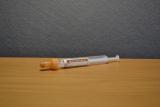Test Directory
Alpha-1 antitrypsin level and phenotype
Containers - Adult

Brown Cap, Gel Clotted
|
Volume Range
1.0 ml
Additive per Container
None |

Red/Pink Cap
|
Volume Range
1.0 ml
Additive per Container
Potassium EDTA |
Containers - Child

Orange Cap - Paediatric
|
Volume Range
0.40 ml |
Reference ranges
1.10 - 2.10 g/L
Laboratory Site
WGH
Crewe Road South
Edinburgh
EH4 2XU
Edinburgh
EH4 2XU
Telephone (Biochemistry): 0131 537 1910/1
Anticipated turnaround
14 days
General additional information
Alpha-1 Antitrypsin (A1AT)
A1AT is a serine protease inhibitor (Pi) that acts primarily to protect lung tissue from damage by the body’s own enzymes. Normal serum levels of A1AT are 1.1 to 2.1g/L. A1AT is a slow acute phase reactant with serum levels rising two to three fold within days of trauma, acute infection or tissue necrosis. The quantitation of A1AT is indicated in the evaluation of chronic obstructive airway disease (COPD), emphysema and in neonatal and adult liver disease where low levels may have diagnostic importance.
Laboratory policy for performing A1AT Phenotyping
The Clinical Biochemistry Laboratory (WGH) performs A1AT quantitation on all A1AT requests and subsequently A1AT phenotyping where any of the criteria below are met.
· A1AT level is less than or equal to 1.1 g/L.
· Children (18 years or less).
· A1AT phenotyping specifically requested.
Therefore, where phenotyping is required, irrespective of the A1AT concentration or age of patient (eg family studies), please make this clear with the request.
Over 100 different alleles of A1AT have been identified. Allele frequencies vary between different populations. The normal allele is M and is present in around 90% of individuals. There are many rare non-deficiency alleles.
A1AT Deficiency
A1AT deficiency is an inherited disorder and severe genetic deficiencies of A1AT (less than 0.6g/L) occur in the UK with an incidence of about 1:2,000. Typical clinical presentations include chronic obstructive airway disease (COPD) with severe lower lobe panlobular emphysema occurring between 30-40 years of age; neonatal cholestasis and progressive juvenile cirrhosis; and some cases of cirrhosis in adults. Smoking and atmospheric pollution contribute to the severity of the lung disease in deficient subjects. Some individuals with A1AT deficiency remain healthy throughout their lives.
The Z and S alleles are the most frequent deficiency alleles found. Individuals with the PiSZ phenotype are at increased risk of lung disease, especially if they smoke. Individuals with the PiZ phenotype are at increased risk of both lung and liver disease. The null allele is the allele of complete A1AT deficiency and can only be identified by formal family studies. Therefore, samples showing only one allele on A1AT phenotyping studies are reported as single allelic symbols (PiM) rather than assuming the homozygous state (PiMM).